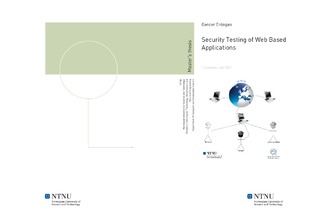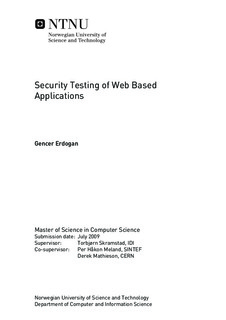| dc.description.abstract | Web applications are becoming more and more popular in means of modern information interaction, which leads to a growth of the demand of Web applications. At the same time, Web application vulnerabilities are drastically increasing. This will inevitably expose more Web application users to malicious attacks, causing them to lose valuable information or be harmed in other ways. One of the most important software security practices that is used to mitigate the increasing number of vulnerabilities is security testing. The most commonly applied security testing methodologies today are extensive and are sometimes too complicated with their many activities and phases. Because of this complexity, developers very often tend to neglect the security testing process. Today, there is only a few security testing methodologies developed especially for Web applications and their agile development environment. It is therefore necessary to give attention to security testing methodologies for Web applications. A survey of state-of-the-art security testing methodologies for Web applications is performed. Based on some predefined criterions, Agile Security Testing is selected as the most adequate security testing methodology for Web applications, and is further extended to support all the predefined criterions. Furthermore, the extended Agile Security Testing methodology (EAST) is integrated into the Software Development Life Cycle applied by the Administrative Information Services group at the Department of General Infrastructure Services at CERN−The European Organization for Nuclear Research. Finally, by using the EAST methodology and the security testing methodology applied by the AIS group (which is an ad hoc way of performing security tests), an evaluation of the EAST methodology compared to existing ad hoc ways of performing security tests is made. The security testing process is carried out two times using the EAST methodology and two times using the ad hoc approach. In total, 9 vulnerability classes are tested. The factors that are used to measure the efficiency is: (1) the amount of time spent on the security testing process, (2) the amount of vulnerabilities found during the security testing process and (3) the ability to mitigate false-positives during the security testing process. The results show that the EAST methodology is approximately 21% more effective in average regarding time spent, approximately 95% more effective regarding the amount of vulnerabilities found, and has the ability to mitigate false-positives, compared to existing ad hoc ways of performing security tests. These results show that structured security testing of Web applications is possible not being too complicated with many activities and phases. Furthermore, it mitigates three important factors that are used as basis to neglect the security testing process. These factors are: The complexity of the testing process, the too time-consuming attitude against security testing of Web applications and that it s considered to lack a significant payoff. | nb_NO |

